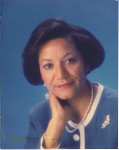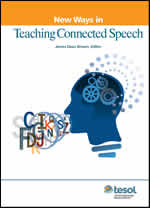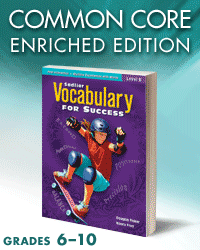Free TESOL Journal Article: "The Use and Misuse of Academic Words in Writing"
by Andrea Marie Cons
This article first appeared in TESOL Journal, Volume 3, Number 4, pgs. 610–638. TESOL members can access all issues for free here. To become a member of TESOL, please click here, and to purchase articles, please visit Wiley-Blackwell. © TESOL International Association.
|
Abstract
This study investigated the specific ways secondary English learners (ELs) and redesignated fluent English-proficient learners (RFEPs) use academic vocabulary that assesses interpretive reading and analytical writing ability. The research examines how ELs and RFEPs, formerly ELs, differ in use and misuse of academic words. The study extends Olson's (2007) work by analyzing how secondary students use academic words correctly and incorrectly. The results indicate that although both groups rarely used academic words, RFEPs used significantly more academic words and made fewer academic word errors than ELs. Qualitative analyses reveal that RFEPs used academic words to add cohesion, details, and precision in their writing to a greater extent than ELs. Findings have three pedagogical implications. First, ELs need more exposure to academic words in writing. Second, ELs need explicit instruction on how to effectively use academic words in writing. Third, ELs need more writing practice in general to become more comfortable with the act of writing so that they will feel more comfortable using more words overall, specifically academic words. Thus, writing should be assigned often. Also, because ELs and RFEPs used few academic words in their writing, both groups need more exposure to and practice with using academic words in writing.
doi: 10.1002/tesj.36 |
Effective vocabulary development has become a burning issue, not just in reading research but also in writing. Composition experts emphasize the critical role of vocabulary in analytical writing (e.g., Astika, 1993; Cortes, 2002; Hakuta, 1974). Analytical writing requires students to be
able to produce an effectively organized and fully developed response within the time allowed that uses analytical, evaluative, or creative thinking. Their writing should include details that support and develop the main idea of the piece, and it should show that these students are able to use precise language and variety in sentence structure to engage the audience they are expected to address. (Loomis & Bourque, 2009, p. 10)
Unfortunately, the number of students in the United States who need extra help learning vocabulary has burgeoned in recent decades. All available research demonstrates that they are often limited in their knowledge of words in analytical writing. In 2007, for instance, the National Assessment of Educational Progress (NAEP) administered a writing assessment to approximately 165,000 public and private school students in Grades 8 and 12 throughout the nation (Salahu-Din, Persky, & Miller, 2008). Fifty percent of public school students in each state (except Connecticut and Massachusetts) were considered nonproficient (at or below basic). The NAEP data also confirm large and consistent gaps between the writing performance of English learners (ELs) and native English speakers.
High-stakes tests such as the California High School Exit Exam (CAHSEE), which all California high school students are required to take and pass prior to graduation from high school, can have serious consequences for students who do not pass. There are negative consequences of failing to do well on national and state tests, such as placement into remedial courses and even failing to earn a diploma.
There is a dearth of research on the academic writing of secondary ELs. As seen in the 2007 NAEP scores, more than half of all secondary students tested were considered nonproficient in writing (Salahu-Din et al., 2008). It is important to consider such data and to learn more about the academic writing of secondary students, specifically ELs.
A major reason that students fail to do well on tests like the NAEP and CAHSEE is that they lack proficiency in vocabulary (Fraser, 1998) and are unable to use academic words effectively in analytical writing (Zamora, 2011). Using a word effectively in this type of writing requires a breadth of word knowledge, entailing, among other things, knowledge of a word's literal meanings, connotations, the grammatical and lexical environments in which it occurs, morphological features, and semantic associates (e.g., synonyms, antonyms). ELs' vocabulary problems increase when they reach secondary schools, where they are exposed to large numbers of academic words and required to use them accurately (Chall, 2000). In fact, at each grade level vocabulary expectations increase dramatically (Nagy, Diakidoy, & Anderson, 1993). ELs who enter school with limited vocabulary knowledge face larger language obstacles than their peers who have rich vocabulary knowledge (Baker, Simmons, & Kameenui, 1997).
Do ELs have the vocabulary proficiency they need to succeed in English language arts classes? What about former ELs who become redesignated fluent English-proficient (RFEP)? What is known about these two groups' abilities and inabilities to use academic words? This article explores such questions, specifically focusing on ELs and RFEPs. In the context of this study, ELs are defined as students who are not yet ready to participate in mainstream courses due to limited English proficiency and require language learning support. RFEPs, on the other hand, have gained enough proficiency in English to read and write at grade level, are placed into mainstream courses, and no longer receive language support (Ragan & Lesaux, 2006).
continued...
This article first appeared in TESOL Journal, 3, 610–638. For permission to use this article, please go to http://www.copyright.com/.
doi: 10.1002/tesj.36
TC Monthly Giveaway Congratulations to Lili Bruess of New Jersey, USA, for being the winner of the December 2012 TESOL Connections Monthly Giveaway. Lili won a free TESOL membership renewal.
This month, TESOL is giving away a free registration to its:
Online Grammar Course: Multiclause Structures
4 February–3 March 2013
This course is for anyone who needs help developing the metalinguistic competence necessary to discuss grammar in the classroom. Read more about the course.
Participants will learn to
-
identify active and passive voice and give reasons for choosing passive voice.
-
identify adverb clauses, adjective (relative) clauses, and noun clauses in sentences.
-
identify and explain the use of participial phrases in sentences.
-
Click here to enter
Don't let the giveaway stop you from registering! If the winner has already registered for the course (and that registration was done after 1 January), the fee he or she paid will be refunded!
TESOL Blogs Interested in writing a blog for TESOL?
Contact Craig Triplett or Tomiko Breland with your idea or for details.
Check out the latest TESOL Blogs:
|
A Whole New World, by Tara Arntsen
 As a new blogger for TESOL, I want to take this opportunity to introduce myself to this wonderful community. My name is Tara Arntsen. I am currently pursuing a Master of Arts in TESOL online with the University of Southern California while teaching English as a foreign language to freshman at Guangdong Peizheng College in Guangzhou, China. I am from the United States but have spent more than 15 years living abroad including time teaching in Japan, Cambodia, and now China. Additionally, I have taught English online both as a freelancer and for various language companies. As a new blogger for TESOL, I want to take this opportunity to introduce myself to this wonderful community. My name is Tara Arntsen. I am currently pursuing a Master of Arts in TESOL online with the University of Southern California while teaching English as a foreign language to freshman at Guangdong Peizheng College in Guangzhou, China. I am from the United States but have spent more than 15 years living abroad including time teaching in Japan, Cambodia, and now China. Additionally, I have taught English online both as a freelancer and for various language companies.
With the importance of technology in our daily lives growing each year, I have become quite interested in technology and its role in education. I believe that teachers around the world, regardless of content area, should devote some time to this topic and develop their own skills as well as the skills of their students. Read More. |
|
Global Resources in ESP: Focus on Self-Directed Learning, by Kevin
 Hello, ESPers worldwide! Hello, ESPers worldwide!
One of my favorite things to tell my students is that they should study English 24/7 (24 hours a day, seven days a week). Of course, my students understand that I am exaggerating to a certain extent. However, I do want my students to make efforts outside of the classroom to learn English. Read More. |
|
The TESOL Symposium Facilitating Learning Through Student Empowerment: An Overview, by Maria Antonia Irizarry
 Editor’s Note: The symposium papers discussed in this blog posting are available in the TESOL Resource Center. Just click on “Find a Resource” and then in the top dropdown menu, choose “White Papers & Live Events.” Editor’s Note: The symposium papers discussed in this blog posting are available in the TESOL Resource Center. Just click on “Find a Resource” and then in the top dropdown menu, choose “White Papers & Live Events.”
The TESOL Symposium “Facilitating Learning Through Student Empowerment” was held in San Juan, Puerto Rico, on 15 November 2012 in partnership with the 36th PRTESOL Convention and the 11th Central American and Caribbean Basin Regional Conference. Read More. |
TESOL Bookstore BRAND NEW RELEASE FROM TESOL PUBLICATIONS
 New Ways of Teaching Connected Speech New Ways of Teaching Connected Speech
James Dean Brown, Editor
Connected speech is based on a set of rules used to modify pronunciations so that words connect and flow more smoothly in natural speech (hafta versus have to). Native speakers of English tend to feel that connected speech is friendlier, more natural, more sympathetic, and more personal. Is there any reason why learners of English would prefer to be viewed as unfriendly, unnatural, unsympathetic, and impersonal? The great news is that such rules can (and should) be explained and taught. This book makes available fun and interesting lessons, presented in a systematic way that is directly useful in the ESL/EFL classroom.
Endorsed by Nina Weinstein
Author of Whaddaya Say (Pearson)
Dr. Brown’s collection of articles includes sentence blending rules, assimilation, reduced forms, and other rules that comprise the natural pronunciation changes of real spoken English. These articles and classroom materials will give teachers a framework to prepare their learners to begin to understand real English speakers.
List $49.95; Member $38.50
Order from the TESOL Bookstore
Toll Free: 888-981-0041
E-mail: tesol@brightkey.net
Order #769
ISBN 9781931185769
|
 |
|
|
 |
| English Instructor, St Mary College-Nunoike Gaikko Senmon Gakko/Nunoike Culture Center, Nagoya, Japan
Director, Intensive English Program, Western Carolina University, Cullowhee, North Carolina, USA
Dean, Adult Basic Ed, GED & ESL, College of Lake County, Grayslake, Illinois, USA
Lecturer in English Language Studies, Massachusetts Institute of Technology (MIT), Cambridge, Massachusetts, USA
Intensive English Program Faculty (Full-Time), Spring International Language Center, University of Arkansas, Fayetteville, Arkansas, USA
Want to post your open positions to Job Link? Click here.
To browse all of TESOL's job postings, check out the TESOL Career Center. |
 |
|
 |
| ADVERTISEMENT |

|
 |
 |
 |
 |
| Upcoming TESOL Grammar Courses |
|
 |
|
|
|
 |
|